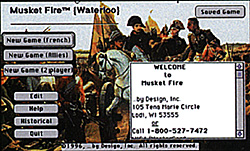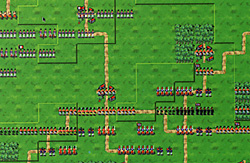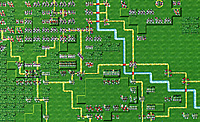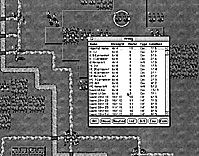
Title: Musket Fire Series, Version 1.5
Designer: Owen Gwynne
Number of Players: One or two
Playing Time: 1-2 hours for each game.
Complexity Level: Low.
Packaging: Plain shipping mailer (no box).
Scale: Grand tactical with units representing regiments or brigades (artillery in multiple battery groupings).
Map and Playing Pieces: All components exist within the computer and appear on the screen. Each square on the game board is approximately 400 yards. Units have strength points, each point equal about 250 men or 3-8 guns. Extensive use is made of pull down menus.
Rules: Contained in a digital format and included on the disk. These are illustrated and cover the game functions/interface as well as giving an abbreviated set of hints for the game system in general.
Scenarios: There is one basic scenario to each set, with some of the titles having additional "what-if" set ups.
Historical Background Information: Very brief, presented at the start up screen of each title.
Format Tested: Macintosh system 7+
Media: 3.5" floppy diskette
System Requirements: Any Macintosh or PowerMac capable of running system 7.0 or better.
Publisher: by Design, Inc.
Publication Date: Originally 1996 with upgrades being added.
Stock Number: None
List Price: $24.95 per set. Available only from: by Design, Inc., 105 Tena Marie Circle, Lodi, WI 53555-1364 USA, or call (800) 527-7472; E-mail: DesignInc@aol.com
Summary: Musket Fire is a Macintosh-only computer game depicting several battles of the Napoleonic Wars at a regimental/brigade level. Easy to learn and quick to play, Musket Fire'squality graphics gives the impression of playing with miniatures.
At a time when IBM and its clones rule the marketplace, it is nice to see a company making an effort to produce historical games for the Macintosh. The three "sets" or scenarios of the Musket Fire system are a good attempt that will only get better with the frequent upgrades that by Design, Inc. is releasing.
Unlike many computer games which have been rushed into production before they are properly tested, these sets are sound and not a single bug was found in repeated playings. (Suggestion: If some of the units don't display properly, quit the program and increase the memory allocation for the program from the information window.)
Musket Fire is currently the core engine for three fairly evenly balanced battle sets or scenarios: Austerlitz, Borodino, and Waterloo. Players can choose either the French or the Allied side and in each battle both sides have a liberal amount of the three maneuver elements found in the game: infantry, cavalry, and artillery. The Artificial Intelligence (A.I.) for each side may be set before play and may be set independently for each side. The highest setting for both sides will create a blood bath as increasing the A.I. increases firepower and morale settings.
Sound Effects
There are some sound effects with the game, that of guns and muskets firing, horses squealing, men grunting when hit, and swords or bayonets clashing. These add to the overall effect initially, but later can be turned off. No soundtrack or music is included. It is worth noting that the game does include pop up menus that give advice and pro-active help that is very helpful for beginners. (Veteran gamers have the option to shut off this feature as well).
The game is graphically pleasing, each unit is represented by a free-standing icon containing five infantry figures, four cavalry figures, or a cannon and two crewmen. Presented in a three-quarters view, each unit is uniformed appropriately. It is obvious that a good deal of research went into this aspect of the game system, as each type of unit, including hussars, cuirassiers, cossacks and guard infantry units of each nationality, are distinctly uniformed. These illustrations enable the players to identify high morale or special units at a glance, rather than having to search through many formations to find these troops. A flag of the appropriate nationality indicates a leader attached to a unit. Routed units are shown with the troops throwing down their weapons and fleeing.
Varied Terrain
The terrain is varied with hills, roads, rivers, forests, bridges, towns, and redoubts. Its depiction is somewhat like a cross between a miniatures tabletop (little buildings and planks in the bridges) and a board game (clumps of trees and square edge hills). The map is covered by an invisible square grid which regulates movement and defines weapon ranges.
Play of the game is simple and smooth. Units are rated for strength, morale, fire combat, and melee. Strength is the actual manpower of the unit and the other values are affected by any decrease in strength. Infantry may be in line, column, square, or all around (used when defending a town or redoubt). Cavalry may only be in line or column and artillery is limbered (for movement) or unlimbered (for firing).
Units have a number of movement points they may utilize to move, charge, fire, or change formation. Column formation is more conducive to movement, but inhibits fire. Moving in a line costs much more in terms of movement points but allows for the greatest concentration of firepower. The game does not allow stacking (more than one unit in a square) or movement through any other unit except artillery. Infantry have a fire range of one, while artillery may fire up to three squares. In addition, artillery may ignore intervening units (fire over them). Forests and towns block line of fire for artillery.
Morale
The single most important rating of the units in Musket Fire is the morale value. Units with poor morale will not stay around for long (and thereby give victory points to the enemy when they run), nor will they be of much use in taking ground since they frequently refuse to enter melee. Morale drops rapidly with combat losses and routs. Units may attempt to rally, but if their morale is too low, don't count on it. It's incredibly frustrating to appear to be in a position to sweep away your opponent only to have your units fail to charge due to their poor morale.
 There is no command or control system per se, but the presence of a leader with a unit results in an increase in morale. Leaders may move from unit to unit once per turn (regardless of the leader's corps affiliation), and each level of leader (corps and army) has the same effect on play, no matter what their nationality or actual battlefield performance was. Leaders in the game are not wounded or killed dierctly, but if a unit with a leader attached is destroyed, so is that leader. Players control every friendly unit on the map unless it has routed and not rallied.
There is no command or control system per se, but the presence of a leader with a unit results in an increase in morale. Leaders may move from unit to unit once per turn (regardless of the leader's corps affiliation), and each level of leader (corps and army) has the same effect on play, no matter what their nationality or actual battlefield performance was. Leaders in the game are not wounded or killed dierctly, but if a unit with a leader attached is destroyed, so is that leader. Players control every friendly unit on the map unless it has routed and not rallied.
Players may click on (choose) opposing units and get a current status of their strength and morale. The ability to see the enemy in detail like this, especially their morale, enables you to find the weak points in the line and break your foe's army. This isn't realistic. Using the fog of war option helps restrict what you can see, but doesn't completely solve this problem. Although tempting, I simply try not to click on the opposing units when I play.
Problem
Game play is sequential, with one side moving and fighting with everything it wants to, then the other side doing the same to complete a turn. Herein lies the biggest problem with the game, a fault the system shares with many board and miniature games. Since units will always respond to the player's orders (unless routed), it is possible to achieve a degree of coordination that would be impossible on an actual Napoleonic battlefield. Players may simply batter an enemy unit to death with successive assaults and fires before the other side can respond.
Designer Owen Gwynne responded that he agreed that this may be unrealistic, but he emphasized that there isn't much of a game at all if this type of action is replaced with the high frustration level of a game that has units "running on the edge of chaos....that type of situation is about as much fun as a box of electric shocks". Agreeing with him that playability is important, some effort should still be made to provide incentive for divisions and corps to act together as divisions and corps. Gwynne was amenable to this idea and something along these lines may be seen in a later version of the game.
 The primary method of pushing the enemy out of position is the charge order. Charging is not automatic as units attempting to charge must pass a morale test before they charge. If the unit fails, its turn is over with no charge executed (as indicated with a small dialogue box as shown in the screen shot at right).
The primary method of pushing the enemy out of position is the charge order. Charging is not automatic as units attempting to charge must pass a morale test before they charge. If the unit fails, its turn is over with no charge executed (as indicated with a small dialogue box as shown in the screen shot at right).
Large Screen Shot (slow download: 127K)
If it passes, it will melee with the enemy force. If it is lucky enough to win the melee, the enemy troops will either break and flee the position or will be shoved into the adjacent square to the rear of the melee. If the charge fails, the charging unit ends its move in the square that it entered the melee from. Either way, a pop up window appears with the result of the action.
Zoom in on Action
 There are three levels at which players may observe the action. First is the tactical level which is an up close look at the action. Zooming out one level is the wide view where the entire battlefield (or a good portion of it) is shown at a reduced scale with much smaller icons for the troops. Finally there is the strategic view (as shown at right). This one disposes of the icons and uses colored boxes to denote unit locations. It shows the entire battlefield for players to plan their grand strategy. One especially enjoyable feature of the game is that you can change sides in the middle of the battle!
There are three levels at which players may observe the action. First is the tactical level which is an up close look at the action. Zooming out one level is the wide view where the entire battlefield (or a good portion of it) is shown at a reduced scale with much smaller icons for the troops. Finally there is the strategic view (as shown at right). This one disposes of the icons and uses colored boxes to denote unit locations. It shows the entire battlefield for players to plan their grand strategy. One especially enjoyable feature of the game is that you can change sides in the middle of the battle!
To win the game, the French must score 80 more points than their opponent. For the Allied force to win it must have 50 more points than the French. Points are accumulated for each enemy unit routed or destroyed, for the capture of key locations, and for each enemy leader eliminated. There is a time limit of 25 turns in each game.
Additionally, players may change the original battles with a scenario editor. While it does not allow you to create extra units or modify the units present at a battle, it does enable the starting deployment positions to be modified extensively. Thus, at Waterloo you may start the French Imperial Guard at Hougomount and watch the British scramble to counter them!
Three Scenarios
The game offers three different scenarios, Austerlitz, Borodino, and Waterloo.
Austerlitz saw combined Russian and Austrian armies attack the French during December of 1805. Having lured the Allies in by feigning numerical inferiority, Napoleon brought up two additional corps to counter the Allied forces. This gave the French some 73,000 men while the Allies mustered 85,000. Held up by fog and communications problems, the initial Allied success was dramatically reversed by a French strike to the dominant terrain feature in the center of the battlefield, the Pratzen Heights, by Bernadotte's 1st Corps. This cut the Allied force in two and allowed each piece to be defeated in detail. Superior French morale and communications had won the day and destroyed the Third Coalition's field armies.
Of the three battles that Musket Fire attempts to recreate, this is by far the weakest. All of the terrain is in the right place, but the game quickly degenerates into a bloodfest. The lack of any advantage for holding a hill is very glaring. The Allies have a significant number of quality troops, and will seldom choose to to re-enact the disastrous historical move that left their center open. Thus, the French will have little opportunity to recreate history. The Allies, on the other hand, can simply concentrate on wiping out one French column after the other. Needing fewer points than the French, the Allies win this one far more often than the French.
Borodino
 Borodino was the largest battle of the campaign of 1812, with 133,000 French attacking 120,000 Russians dug in along the road to Moscow. The salient features of the battlefield were the Kalatsha River, the town of Borodino, and a series of redoubts built by the Russians. Expecting an attack against his right, Kutusov had weighted that flank heavily (as shown at right).
Borodino was the largest battle of the campaign of 1812, with 133,000 French attacking 120,000 Russians dug in along the road to Moscow. The salient features of the battlefield were the Kalatsha River, the town of Borodino, and a series of redoubts built by the Russians. Expecting an attack against his right, Kutusov had weighted that flank heavily (as shown at right).
Napoleon, however, fearing the steepness of the Kalatsha's banks, launched his major attack upon Kutusov's left. The ensuing battle saw heavy casualties to both sides and much of the Russian army finally pushed out of its fortified positions. But it was not the crushing victory Napoleon needed.
Musket Fire: Borodino recreates this battle by faithfully deploying the French heavily on Kutusov's left. Only Prince Eugene's Italians and a thin smattering of French troops deploy opposite the river and Borodino. The Russians have their redoubts and a large number of fairly high morale troops.
The French must throw themselves against the Russian line in hopes of hurting them somewhere early. Otherwise the Russians will gain time to shift troops from their lightly engaged right and throw back the French assaults. The game grinds down into the same sort of blood bath that historically occurred. The timed release of troops forces the French player into the same sort of piecemeal attacks that allowed the Russian line to stand up for as long as it did, and it also means that the Russian player cannot simply move his entire right wing into the battle all at once.
Thus Musket Fire: Borodino fairly accurately (and frustratingly for the French) depicts the historical battle.
 An option is included to allow the flanking attack proposed by Marshal Davout. This one really changes things for the French as they are no longer limited to a costly frontal assault. For the Russian player, the appearance of these French troops releases some much needed troops for action from the rear area and also reduces the pressure on the front line, as an entire French corps is not there to assault it! An excellent variation to the basic game. (At right, checking the unit status from the army list).
An option is included to allow the flanking attack proposed by Marshal Davout. This one really changes things for the French as they are no longer limited to a costly frontal assault. For the Russian player, the appearance of these French troops releases some much needed troops for action from the rear area and also reduces the pressure on the front line, as an entire French corps is not there to assault it! An excellent variation to the basic game. (At right, checking the unit status from the army list).
Waterloo
The third set is on the battle of Waterloo on 18 June, 1815, and is by far the best of the series. This one is an exciting, close run battle in which the French attempt to break the Anglo-Dutch army before the Prussians show up. The fact that some of the British units are shown in kilts is an added bonus!
The actual battle centered on the strong points of Hougoumont and La Haye Sainte, both of which are portrayed in the game. After defeating the Prussians at Ligny, Napoleon sent part of his army to chase them while he moved most of his forces against Wellington. The British Duke chose his ground near Waterloo and successfully parried every French move until the arrival of the Prussians on the French right and rear sealed Napoleon's fate. The strong points mentioned above were in front of the main Allied line and managed to consume much of the French army's attention until it was too late.
The game portrays this action quite well with those two stubborn strong points becoming the focus of the French assaults. If the French ignore them, the British will pour fire into the French flanks until attacks against the main Allied line become impossible. If the French concentrate on them, however, they will find more and more of their strength being drained to take and hold them. The design includes high British morale and restrictions on moving the French Imperial Guard until after 2:30 pm.
The arrival of the Prussians will most often end the game for the worn out French units will be no match for the fresh Prussians. The French must succeed before they arrive. It is a very tense situation that makes replaying addictive.
As with Borodino, there is an additional scenario where the French troops under Marshal Grouchy arrive in pursuit of the Prussians. This is a great "what if" game and gives the French a second chance if they haven't broken the British yet. This scenario is highly recommended and by Design, Inc. is commended for its inclusion.
Overall
Overall the system is enjoyable and for a Mac user it gives you a lot of game for your money. While there are many historical nuances that can be argued over, Musket Fire is a solid product that can be enjoyed by both the experienced wargamer as well as the beginner with a computer. Regrettably, one feature missing is a play by e-mail system.
Although lacking much of the detail and many of the options of more expensive IBM-based games, this is a fine first effort for by Design, Inc.
Back to Table of Contents -- Napoleon #7
Back to Napoleon List of Issues
Back to Master Magazine List
© Copyright 1997 by Emperor's Press.
This article appears in MagWeb (Magazine Web) on the Internet World Wide Web.
The full text and graphics from other military history magazines and gaming magazines are available at http://www.magweb.com